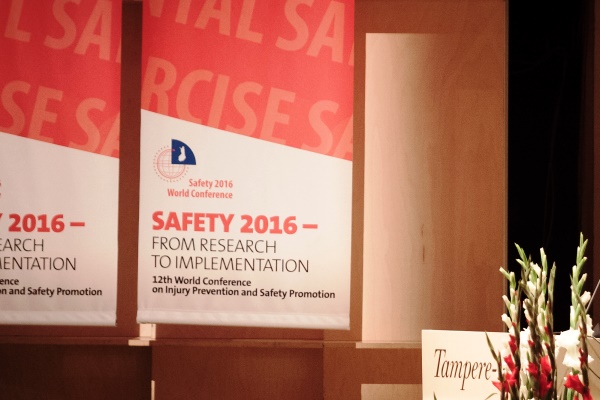Nonkilling at 2016 Safety World Conference
CGNK was actively involved in Safety 2016, the 12th World Conference on Injury Prevention and Safety Promotion, held in Tampere, Finland, on September 18-21, 2016. The Conference was hosted by the Finnish National Institute for Health and Welfare and cosponsored by the World Health Organization with the theme “From research to implementation” and was focused on addressing the gap between knowledge and policy as well as promoting intersectoral preventive action.
 CGNK Director Joám Evans Pim moderated the special parallel session on “Violence”, scheduled for September 20, were he also presented the paper “SUSTAINABLE DEVELOPMENT GOAL 16.1: ARE NONKILLING SOCIETIES POSSIBLE?“. During the same week, CGNK’s Director was invited as Guest Lecturer to Tampere University TAPRI Peace Research Institute’s Master’s degree program in Peace, Mediation and Conflict Research, were he introduced the new 3 ECTS credits course PEACE 40 Violence Prevention. Evans facilitated the participation in the course of several WHO Violence Prevention Alliance colleagues, including Professor Manuel Eisner from the University of Cambridge, Dr. James Mercy from the Center for Disease Control and Prevention, Dr. Larry Cohen and Dr. Rachel Davis from the Prevention Institute and Maria Valenti and Emeka Okolo from International Physicians for the Prevention of Nuclear War.
CGNK Director Joám Evans Pim moderated the special parallel session on “Violence”, scheduled for September 20, were he also presented the paper “SUSTAINABLE DEVELOPMENT GOAL 16.1: ARE NONKILLING SOCIETIES POSSIBLE?“. During the same week, CGNK’s Director was invited as Guest Lecturer to Tampere University TAPRI Peace Research Institute’s Master’s degree program in Peace, Mediation and Conflict Research, were he introduced the new 3 ECTS credits course PEACE 40 Violence Prevention. Evans facilitated the participation in the course of several WHO Violence Prevention Alliance colleagues, including Professor Manuel Eisner from the University of Cambridge, Dr. James Mercy from the Center for Disease Control and Prevention, Dr. Larry Cohen and Dr. Rachel Davis from the Prevention Institute and Maria Valenti and Emeka Okolo from International Physicians for the Prevention of Nuclear War.
The Center for Global Nonkilling also supported the draft of the “Tampere Declaration”, which includes specific references to violence prevention in the context of the newly adopted Sustainable Development Goals. The Declaration identified common aims and principles on injury and violence prevention reached by participants and the representatives of WHO at the Conference during the structured consultation process.
Tampere Declaration of the 12th World Conference on Injury Prevention and Safety Promotion
Tampere declaration (pdf, 146 kb)
We, the participants of the 12th World Conference on Injury Prevention and Safety Promotion, held 18–21 September 2016 in Tampere, call for strong, coordinated whole-of-government and whole-of-society action to reduce the impact of injuries and violence.
We welcome recent injury and violence-related policy discussions in the United Nations General Assembly and the World Health Assembly, which resulted in adoption of several resolutions (1) , including on the Decade of Action for Road Safety 2011 to 2020.
We also welcome the 2030 Agenda for Sustainable Development and its seventeen interdependent Sustainable Development Goals (SDGs) (2). The inclusion of injury- and violence-related targets in this agenda reflects the recognition by world leaders that injuries and violence are a threat to sustainable development, and shows a growing global commitment to tackling these issues.
We remain concerned however that despite increasing attention and commitments, more than 5 million people still die each year because of injuries and violence. Injuries are a leading cause of death among young people globally. Tens of millions of people suffer injuries that require medical treatment and often hospitalization, and injuries may lead to life-long disability. These injuries result from road traffic crashes and other transport, work, burns, drowning, falls, and poisonings, as well as acts of interpersonal violence, suicide and self-harm, including those involving firearms.
Injuries and violence have a substantial physical and psychosocial health impact on individuals. They cost nations a significant proportion of GDP and have a negative economic impact on the injured, their families, and their communities.
We recognize that the burden of injuries and violence, along with their underlying causes and risk factors, are not randomly distributed throughout the world. Nearly 90% of injury and violence-related deaths occur in low- and middle-income countries. Within many countries, people of poorer economic status have higher risk of injuries and injury-related deaths than wealthier individuals. Injury prevention and safety promotion are important tools for reducing avoidable inequalities in outcomes and achieving health equity.
Evidence and experience show that the vast majority of injuries and violence are predictable and preventable. Multisectoral approaches to preventing injuries and violence and limiting their consequences have resulted in dramatic and sustained reductions in morbidity and mortality in some settings. These approaches include changes to policy and legislation – in the health sector and beyond – and behaviour change programmes, and incorporate both individual- and population-level interventions. Such evidence-based interventions are likely to save costs.
Adequate prehospital and facility-based emergency care can dramatically reduce resulting death and disability once an injury has occurred (3), yet most of the world does not have access to essential prehospital and facility-based emergency care.
Community and facility-based data collection are essential to effective planning, implementation and monitoring of violence and injury and prevention and control strategies. Data collection that is standardised and coordinated across sectors allows for more informed decision-making and must be scaled up globally.
As the world orients itself to the 2030 Agenda for Sustainable Development, there is a unique opportunity for coordinated engagement from a range of government and non-government stakeholders in injury prevention and safety promotion. Governments are turning their attention to what can be done to achieve the Sustainable Development Goals and targets, and many will find they need to engage civil society groups, foundations and community-based organizations to reduce the impact of injuries and violence on their nations and communities. Several cross-cutting actions will facilitate scaled-up, effective prevention of injuries and violence.
We therefore issue the following call to action for stronger Injury Prevention and Safety Promotion:
- Develop multisectoral national action plans to implement policy, programmes and legislation for injury and violence prevention and control, with clear targets and monitoring mechanisms.
- Designate focal points and create units for injury and violence prevention within the Ministry of Health, and other ministries as relevant to the national context, for example the Ministry of Transport, Ministry of Interior, Ministry of Labour; strengthen the capacity of relevant ministries to work across sectors in a collaborative and coordinated manner.
- Invest in injury prevention and safety promotion and develop innovative funding mechanisms.
- Adapt, implement and monitor proven strategies at national and local level to reduce risk factors and prevent injuries and violence, including but not limited to legislation, regulation, enforcement, environmental modification, and safety equipment and standards.
- Ensure universal access to essential pre-hospital and facility-based emergency care services.
- Promote expanded access to medical, legal and psychosocial support services and to rehabilitation for the injured and their families, and expanded access to services for those at risk of injury or violence.
- Raise awareness and improve health literacy by improving communication and dissemination of information on the impact of injuries and violence, and effective prevention and control strategies. Integrate injury and violence prevention into other health and safety advocacy platforms.
- Build community capacity to identify local injury and violence priorities and to take effective action to prevent injuries and violence and improve outcomes. Develop local platforms to engage multiple stakeholders in dialogue and advocacy, such as those created through the Safe Communities movement.
- Strengthen standardised national and community- and facility-based data collection on fatal and non-fatal injuries and violence, in order to reveal the true magnitude and allow more effective development and monitoring of prevention and control initiatives. Collect and disaggregate data sufficiently, and use it to analyse gender, socioeconomic and other inequities that underlie patterns of injury and violence.
- Encourage improved external cause of injury (in addition to diagnosis) coding, utilisation of standard core data sets for injury. Fund research that expands the scientific evidence base for both prevention and improved outcomes for the injured, including research on risk factors and underlying causes.
- Strengthen capacity building for injury prevention and safety promotion, including education, training and professional development to facilitate effective research, policy development, provision of care, system organisation and coordination, advocacy and data collection.
- Encourage the participation of civil society and the private sector in injury and violence prevention. Review actions of industry to ensure they promote injury and violence prevention consistent with current evidence.
- Take action to implement existing global and regional injury-related commitments, such as United Nations General Assembly resolutions, World Health Assembly resolutions and the plan of action for the Decade of Road Safety 2011 to 2020.




